Common rail 2AD-FHV
Components


Common rail 2AD-FHV
Removal
CAUTION:
Wait at least 90 seconds after disconnecting the cable from the negative (-) battery terminal to prevent airbag and seat belt pretensioner activation.
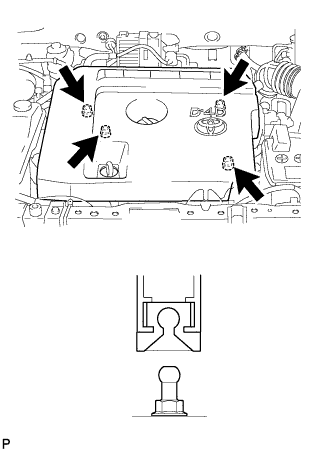
-
Detach the 4 clips and remove the engine cover.
-
Disconnect the fuel pressure sensor connector.
-
Disconnect the pressure discharge valve connector.
-
Disconnect the turbo pressure sensor connector.
-
Remove the grommet and nut and disconnect the glow plug wire harness.
-
Remove the 2 nuts and disconnect the engine wire from the engine cover bracket.
NOTICE:
After removing the fuel inlet pipe, cover the common rail and injection or supply pump with electrical tape to prevent dirt from entering them.
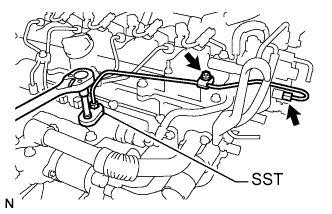
-
Remove the nut and fuel inlet pipe clamps.
-
Using SST, remove the fuel inlet pipe.
SST:
09023-38401
NOTICE:
After removing the injection pipe, cover the common rail and injector with electrical tape to prevent dust from entering them.
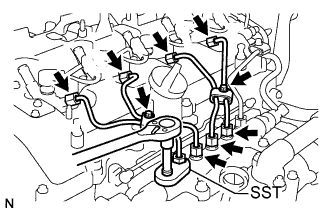
-
Remove the 2 bolts and 4 injection pipe clamps.
-
Using SST, loosen the 4 nuts at the common rail end of the injection pipes.
SST:
09023-38401
-
Using SST, loosen the 4 nuts at the injector end of the injection pipes.
SST:
09023-38401
-
Remove the 4 injection pipes.

-
Using pliers, grip the claws of the clip and slide the clip to disconnect the pressure fuel hose.
-
Remove the 2 bolts, common rail and intake manifold insulator.
Common rail 2AD-FHV
Inspection

-
Inspect the fuel pressure sensor.
-
Measure the resistance of the sensor.
HINT:
Perform the inspection with no fuel pressure applied.
Standard resistance:
If the result is not as specified, replace the common rail assembly.Tester Connection Specified Condition 5 (PR) - 4 (E2) 16.4 k? or less 2 (PR2) - 3 (E2S) 16.4 k? or less 6 (VC) - 5 (PR) 3 k? or less 1 (VCS) - 2 (PR2) 3 k? or less
-

-
Inspect the pressure discharge valve.
-
Measure the resistance of the valve.
Standard resistance:
Tester Connection Condition Specified Condition 1 - 2 20°C (68°F) 0.85 to 1.05 ? HINT:
The temperature indicated in "Condition" is the temperature of the pressure discharge valve.
If the result is not as specified, replace the common rail assembly.
-
Common rail 2AD-FHV
Installation

-
Install the intake manifold insulator and common rail with the 2 bolts.
Torque:
20.5 N*m{ 209 kgf*cm , 15 ft.*lbf }
-
Using pliers, grip the claws of the clip and slide the clip to connect the fuel hose as shown in the illustration.
NOTICE:
In a case where the common rail is replaced, the injection pipes must also be replaced.

-
Temporarily install the 4 injection pipes.
-
Using SST, tighten the 4 nuts at the common rail end of the injection pipes.
SST:
09023-38401
Torque:
27 N*m{ 275 kgf*cm , 20 ft.*lbf }
HINT:
- Use of the proper SST is required to ensure that the correct torque is applied to the injection pipe nut.
- Use a torque wrench with a fulcrum length of 30 cm (11.81 in.).
- Make sure that the pipe is not deformed or twisted during installation. If the pipe is deformed or twisted, or if it cannot be installed properly, replace the pipe with a new pipe.
-
Using SST, tighten the 4 nuts at the injector end of the injection pipes.
SST:
09023-38401
Torque:
27 N*m{ 275 kgf*cm , 20 ft.*lbf }
HINT:
- Use of the proper SST is required to ensure that the correct torque is applied to the injection pipe nut.
- Use a torque wrench with a fulcrum length of 30 cm (11.81 in.).
- Make sure that the pipe is not deformed or twisted during installation. If the pipe is deformed or twisted, or if it cannot be installed properly, replace the pipe with a new pipe.
NOTICE:
- In a case where the common rail is replaced, the fuel inlet pipe must also be replaced.

-
Temporarily install the fuel inlet pipe with the 2 clamps and nut.
-
Using SST, tighten the nut at the common rail end of the fuel inlet pipe.
SST:
09023-38401
Torque:
27 N*m{ 275 kgf*cm , 15 ft.*lbf }
HINT:
- Use of the proper SST is required to ensure that the correct torque is applied to the inlet pipe nut.
- Use a torque wrench with a fulcrum length of 30 cm (11.81 in.).
- Make sure that the pipe is not deformed or twisted during installation. If the pipe is deformed or twisted, or if it cannot be installed properly, replace the pipe with a new pipe.
-
Using SST, tighten the nut at the supply pump end of the fuel inlet pipe.
SST:
09023-38401
Torque:
27 N*m{ 275 kgf*cm , 20 ft.*lbf }
HINT:
- Use of the proper SST is required to ensure that the correct torque is applied to the inlet pipe nut.
- Use a torque wrench with a fulcrum length of 30 cm (11.81 in.).
- Make sure that the pipe is not deformed or twisted during installation. If the pipe is deformed or twisted, or if it cannot be installed properly, replace the pipe with a new pipe.
-
Tighten the fuel inlet pipe clamp nut.
Torque:
5.0 N*m{ 51 kgf*cm , 44 lbsf.in }
-
Connect the engine wire to the engine cover bracket.
-
Connect the glow plug wire harness.
-
Install the 2 nuts.
-
Install the nut and grommet.
Torque:
2.2 N*m{ 22 kgf*cm , 19 lbsf.in }
-
Connect the turbo pressure sensor connector.
-
Connect the pressure discharge valve connector.
-
Connect the fuel pressure sensor.
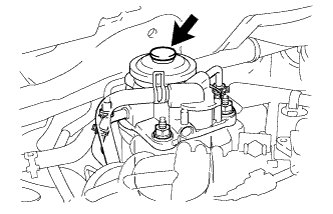
-
Using the hand pump indicated by the arrows in the illustration, bleed the fuel system. Continue pumping until pumping becomes difficult.
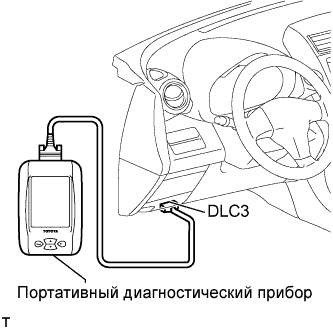
-
Perform the ACTIVE TEST.
-
Connect the intelligent tester to the DLC3.
-
Turn the ignition switch on (IG).
-
Turn the intelligent tester ON.
-
Enter the following menus: Powertrain / Engine / Active Test.
-
Perform the Active Test.
Intelligent Tester Display Test Details Control Range Diagnostic Notes Test the Fuel Leak Pressurizing common rail internal fuel pressure, and checking for fuel leaks Stop/Start - Fuel pressure inside common rail pressurized to specified value and engine speed increased to 2,000 rpm when Start is selected
- Above conditions to be maintained while test is Start
-

-
Attach the 4 clips to install the engine cover.